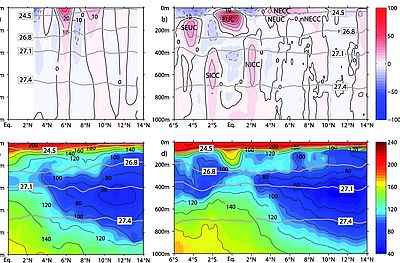The objective of A4 is to understand how oxygen minimum zones (OMZs) are maintained by ocean circulation and what are the scales of temporal variability in OMZs and the physical supply of oxygen to them. Subproject A4 will contribute to the dynamical understanding of advective ventilation pathways and to the quantification of lateral eddy-driven oxygen fluxes. It is observationally based on shipboard and continuous longterm moored observations, on a temporary sub-mesoscale mooring array (in conjunction with a tracer release and glider swarm experiment performed by A3) and process simulations with idealized geometry and forcing. It will provide a key reference data set of oxygen and current variability within the Eastern Tropical North Atlantic (ETNA) with relevance for the entire SFB and aims to develop new parameterizations of ventilation processes not resolved in ocean GCMs and coupled ocean-atmosphere GCMs.
During the first phase, latitudinally alternating zonal jets (LAZJ) were identified as a significant contribution to the ventilation of the Eastern Tropical North Atlantic oxygen minimum zone (ETNA OMZ) via zonal advection.
Changes in the strength of the LAZJ were conjectured by comparing historical hydrographic and recent current and hydrographic data (Brandt et al., 2010) as contributing to the expansion of the ETNA OMZ during recent decades. Equatorial deep jets (EDJ) are found to be an important ventilation pathway for the equatorial Atlantic at intermediate depths (Brandt et al., 2008; 2011). The goals of the second phase are 1) to improve our understanding of ocean dynamics responsible for the generation of LAZJ and EDJ and their effect on the oxygen distribution and 2) to quantify hydrographic and current variability within the OMZ and associated lateral oxygen fluxes with a particular focus on the role of mesoscale processes. While the observation al program will concentrate on the tropical NA, the process modelling is aimed in general to improve our understanding of ventilation pathways toward tropical ocean OMZs and their variability.
The first goal will be achieved by a combination of process modelling and observations including a single equatorial mooring. Key objectives are:
- Continuously observe the current and density field at the equator allowing identification of intraseasonal wave and EDJ characteristics.
- Quantify the zonal oxygen flux in the equatorial band from the well-ventilated western boundary to the east by the mean flow and interannually varying EDJ using moored and repeat shipboard observations.
- Perform idealized high-resolution simulations using geometry that is representative of the tropical Atlantic to study the generation mechanism of both LAZJ and EDJ. Different forcing mechanisms, e.g. idealized intraseasonal waves, tropical instability waves, intraseasonal fluctuations of the western boundary current system will be considered.
- Identify the most realistic numerical simulations by comparing model output with data sets that are already available and that will be obtained within the project.
- Develop strategies for parameterization of the effect of LAZJ and EDJ for the ventilation of the OMZs in models that are not able to simulate these processes, i.e. ocean GCMs and coupled ocean-atmosphere GCMs.



